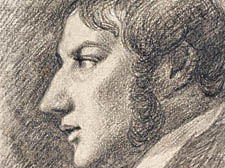|
|
 |
| |

Self-portrait, 1806 |
Sky falling in on the life of Constable
A surprise exhibition of portraits and a new biography show a troubled period in the great landscape painter’s career and his reaction to the loss of the love of his life, writes Gerald Isaaman
EVERY picture tells a story. And if you make it to the National Portrait Gallery to see the unexpected display of Constable portraits you may come away disappointed.
Undoubtedly, this is a worthwhile and historically important exhibition in that it shows comprehensively – and for the first time – some 100 paintings from John Constable’s past never seen together before. Yet they are not comparable to his truly great landscapes. There are a handful of exceptions, notably his pencil drawings and enchanting portrait of his wife, Maria Bicknell – a remarkable resemblance that he kept close to him always.
But the work in general, which includes newly identified portraits of his East Bergholt parents, is hesitant, unsure and that of an unhappy artist, forced to use his talents to earn a living while his smouldering ambition for the open country and the sky was chained and stifled.
“Painting for me is but another word for feeling,” he famously said. You can see that in his glowing affection for smiling, grey-eyed Maria. Equally, he recorded the comment: “Landscape is my mistress – ’tis to her I look for fame.”
And for the compelling saga of his reluctance to paint people, rather the serene rural scenes of the Stour valley that earned him his place in posterity, you need to read Martin Gayford’s admirable Constable in Love.
The dichotomy of these two vital poles in Constable’s life provides the excitement of a new look at the depth of his determination and passion to succeed.
Gayford has co-curated the exhibition with the Tate’s Constable expert Anne Lyles, and he is essentially aware of the nature of the man who insisted: “If I were bound with chains I should break them.”
Constable would do so for the woman he first met when he was 24 and she half that age – the handsome Suffolk miller’s son subsequently setting his cap at the daughter of a successful London lawyer with royal connections who was adamant that his Maria would be the bride only to a man with the means to sustain a contented life in society, not some ambitious artist with little to offer.
Gayford tells the story with equal loving care as Constable, slowly and sensitively, wooed his bride during the harsh years of war with France.
That childhood association, as well as the humble fields and river scenes that provided Constable with the subjects for his later masterpieces, are an innate part of the story that has, until now, been lost.
Perhaps the fact that Constable’s artist friend CR Leslie produced his biography of the painter just six years after his death, thus prematurely closing the door to new researchers, has inspired others to go in search of new truths.
Gayford has found them in newly published correspondence, including a remarkable letter to Pitt the Younger, and even sermons, as well as his social portraits after surprisingly being set on the trail in Paris. That was where Constable’s talent won him his first tributes.
Disappointingly, Gayford devotes little attention to the 12 years of Constable’s marriage from 1816, during which Maria was too often pregnant.
While he fills out her intelligent and loyal character as never before, there is no mention that beloved Maria, aged 41, died in Constable’s arms — from tuberculosis — at No 40 Well Walk, Hampstead, in 1828.
Constable wrote to his brother Golding: “Hourly do I feel the loss of my departed Angel – God only knows how my children will be brought up… the face of the world is totally changed to me.”
And he forever wore mourning until his own demise at his studio in Charlotte Street, Fitzrovia, in 1837, his paintings having become darker and more sombre as the years past.
Alas, a blue plaque does not adorn the Hampstead house, nor are any of the other Hampstead properties where the Constables lived identified, which will prevent those enthralled by this compulsive love story to follow it to its natural end.
Why? “The answer is that my conception of the book was that it would have the same shape as a 19th-century novel, ending with a wedding,” Gayford tells me.
“After that ceremony, the evidence is different and much more spasmodic, as Constable and his wife were naturally living together and seldom needed to send each other letters.
“So the answer is that the Hampstead years really belong to a different book.”
Let’s hope he writes it. For all that love – and heartbreak – still lie in close proximity under familiar skies in the family tomb of John Constable, Maria and their offspring, in a corner of Hampstead Parish Churchyard, and much in need of restoration.
|

|
 |
|
 |
|

